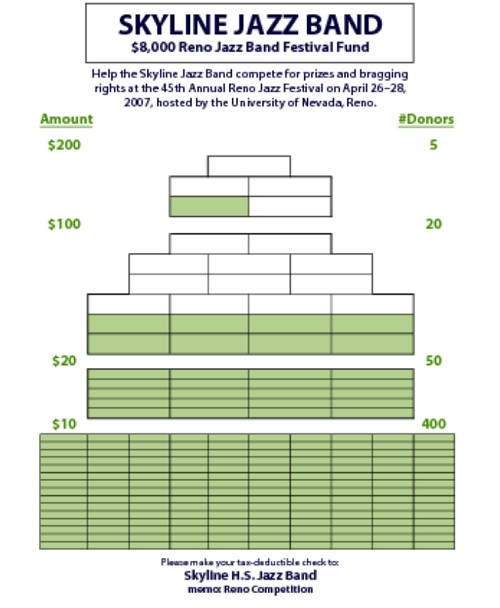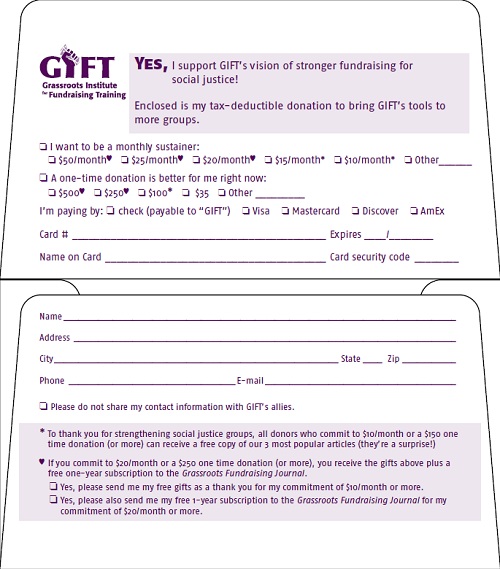
Mark Toney recently gave a very successful pitch raising $8,000 at GIFT’s Money for Our Movements conference last August.
Some of the components that made Mark’s pitch so successful were:
- The timing, The pitch came right after a lively debate. The majority of conference attendees were in the room and were feeling energized by the recent discussion.
- The tone. Mark brought a lot of energy to the stage and got people enthusiastic about GIFT’s work and supporting that work.
- The matching gift approach. Mark asked people to match his gift and the other larger gifts. He identified a few people ahead of time to agree to make larger gifts, which in turn encouraged others to give.
Following his pitch, he facilitated a workshop for conference attendees called “Raps that Raise Money: Fundraising at Any Gathering.” In this issue, we are including this helpful planning guide and some tips from Mark Toney’s workshop to assist you in planning your next event and fundraising pitch.
Setting Your Fundraising Goals
Where does this event fit into your current development plan?
What is your annual donor campaign fundraising goal?
How much are you hoping to raise from the event?
How many donations at what amount will help you to raise your fundraising goal?
|
Donation Amount |
Number of Donations |
Total |
|
|
|
|
|
|
|
|
|
|
|
|
|
|
|
|
|
Total Donations |
|
|
Set a fundraising goal that is realistic.
In setting your goal, consider the following questions:
- How much money did we raise from individual donors the year before?
- What strategies (end of year mailing, special events, online campaign, etc.) worked well? Whether it is $5,000, $25,000, or $50,000, identify which strategies you plan to implement and how much you intend to raise from each.
Based on your annual individual donor fundraising goal, set a specific goal for donor contributions at event. Whether it is $1,000 or $10,000, set a realistic goal based on expected number of attendees and gift range goals. Aim for a specific percentage of your overall fundraising goal to come from the event.
Preparing and Creating Your Fundraising Materials
- Create a donor pyramid chart.
Place many smaller donations at base with fewer larger donors at top. This will help you identify how many gifts you need at each level to reach your goal.

- Make a poster size pyramid donor chart.
Create boxes with room to write names of donors. This is a great visual to put up in the office to track gifts, donors, fundraising goals, and progress leading up to the event.
- Create a donation form for donors to fill out.

- Consider donor perks/thank you gifts for a select number of donors.
This must be something exclusive, which cannot be sold or bought. Consider a piece of artwork members of the organization made, some type of organizational swag (like a coffee mug, t-shirt, magnet, or bag that promotes the organization and/or highlights a recent successful campaign), or a free training/skill share with another ally organization. If you have an online fundraising component, many of the online platforms like Indiegogo have this built into their campaigns.
- Plan to collect contact information of every person who attends the event.
Contact information is more important than money. Make sure sign-in sheets have space for email and mailing addresses, phone numbers, as well as a box to check for people who want more information or would like to get more involved.
Sign up for our free newsletters
Subscribe to NPQ's newsletters to have our top stories delivered directly to your inbox.
By signing up, you agree to our privacy policy and terms of use, and to receive messages from NPQ and our partners.
- Send email or snail mail thank yous to all who attended and include fundraising results.
A handwritten thank you goes a long way. Make sure to set aside time after the event to send handwritten thank you cards to everyone who made the event possible (caterers, committee members, co-chairs, speakers, on site volunteers, and more) and donor acknowledgement letters. Schedule a time when key organizers, staff, and volunteers can help to write personalized notes. Also, provide people with another opportunity to give.
• Document the event.
Make a communications plan in advance of the event to share photos, videos, and other highlights from the event, including the fundraising success. This a great way to build buzz and direct traffic to your website and social media outlets like Twitter and Facebook. It may also inspire others to get involved or give a donation even after the event.
Key Components of a Successful Rap
Welcome
- Introduce yourself
- Thank people for coming
- Remind them of purpose of event
Lead with key messages.
- Appeal to values: social justice, racial and economic justice, vision for future.
Follow with specific impact.
- Highlight key victories or accomplishments.
Make the ask of specific amount ($100 or more).
- Remind them of the worthiness of the cause.
- Remind them of their value as supporters.
- Make the first gift yourself.
- Tell them you need at least 10 other people to match your gift.
- Invite people to make donations both higher and lower.
Repeat the ask if possible.
- Read off the names of people who have given checks.
- Give people an update of amount raised, and remaining to hit goal.
This should all take about 10 to 15 minutes at most.
- 5 minutes for initial ask.
- 5 minutes to massage a response.
- 5 minutes to read names and ask again.
Preparing for the Rap
What is amount of initial ask (at least $100)?
Identify the range of what you will ask for and how many gifts at each amount you are trying to raise as part of the overall fundraising goal. Refer to your handy donor pyramid chart you made when figuring out what your range and goals for the pitch will be. Your initial ask amount can start in the middle range, then offer both higher and lower amounts. Or you can start at the highest ask amount (especially if you have a matching gift donor already established), then work your way down in ask amounts.
Cross check how much money was raised in advance of the event (from ticket sales, sponsorships, fundraising teams, etc.), and share that amount with the audience. Be up front about how much you need to raise from the pitch and how many people you need to give at each amount.
Who will you recruit to donate early?
Identify at least three to five people (if possible) in the audience who have already committed to giving at one of your higher amounts or as monthly sustainers depending on what your fundraising goals are.
What key messages and accomplishments do you want to highlight?
Use this opportunity to highlight the work and successes of the last year. This is a great time to share the launch of a new program or something else that people’s money will be helping to support. Make it as concrete as possible. Share the overall fundraising goal openly and let folks know how many people you need to give at a given amount.
Most of all, speak from your heart and share why the work matters to you personally and politically. It doesn’t have to be a sob story, but sharing emotion and conviction can definitely make the pitch more effective.
Who is best positioned to deliver the rap at the event?
Are there one or two people who are strategically positioned to make the ask? Who is a compelling speaker that the audience will respond to best? Is there a new member, staff person, board member, volunteer, or organizational ally who you want to feature? Consider finding someone who is a strong, charismatic speaker who will be able to handle silence in people’s response while keeping the energy up in the room.
Delivering the Rap
Timing is everything!
Make sure to keep the overall program short. If people are tired and have been sitting and listening to a lot of speakers or watching a set of performances, they may be less likely or motivated to give. Find a moment in the middle of the program when energy is up and people are feeling inspired to make the ask.
Collecting checks from the audience
Place staff, board members, organizational leaders, and volunteers in the audience with baskets to collect remit slips and checks. Make sure to have enough collectors in each section of audience so it is easy to move around the room and collect donations as people make pledges. Also, consider what room configuration will make it easiest for donors to give and collectors to move around the room.
Mark Toney is an experienced social justice fundraising and organizational leader. He has served as executive director of The Utility Reform Network, Center for Third World Organizing, and Direct Action for Rights & Equality.













